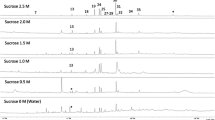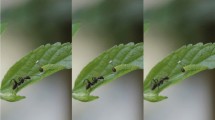Summary.
Nestmate recognition systems in ants are largely based on chemical signals. The hydrocarbon fraction of the lipid layer which covers the insect cuticle plays a determinant role in this context. Here we report a novel extension of nestmate and alien recognition – nest area marking with faeces containing the same hydrocarbons as the cuticle of workers – in a harvesting ant, Messor capitatus. Workers of M. capitatus deposit large quantities of brown-yellow material from the hindgut (termed spots) in the vicinity of the nest. Behavioural investigation showed that such spotting behaviour has a communicative value in the context of nest area identification. Anal fluids deposited in the nest surroundings contain colony-specific cues which the ants use to recognize their own nest areas, and distinguish them from foreign areas even in the absence of nestmate or alien ants. Chemical analyses by gas chromatography-mass spectrometry (GC-MS) of the contents of anal spots, rectal sacs, and cuticular extracts revealed that all contain the same long-chained linear and branched hydrocarbons in varying proportions. Importantly, multivariate analyses showed that the relative proportions of these compounds on the cuticle and in spots are colony-specific. This provides a mechanism by which spot marking could be used by workers to define and recognize their colony area, and would represent a simple extension of the existing nestmate recognition template based on colonial cuticular signatures. The ecological and sociobiological implications of these findings are discussed.
Similar content being viewed by others
Author information
Authors and Affiliations
Corresponding author
Additional information
Received 3 February 2004; revised 10 June 2004; accepted 14 June 2004.
Rights and permissions
About this article
Cite this article
Grasso, D.A., Sledge, M.F., Moli, F.L. et al. Nest-area marking with faeces: a chemical signature that allows colony-level recognition in seed harvesting ants (Hymenoptera, Formicidae). Insectes Soc. 52, 36–44 (2005). https://doi.org/10.1007/s00040-004-0762-0
Issue Date:
DOI: https://doi.org/10.1007/s00040-004-0762-0




